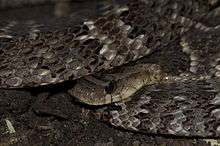Xenodon rabdocephalus
| Xenodon rabdocephalus | |
|---|---|
 | |
| Scientific classification | |
| Kingdom: | Animalia |
| Phylum: | Chordata |
| Class: | Reptilia |
| Order: | Squamata |
| Suborder: | Serpentes |
| Family: | Colubridae |
| Genus: | Xenodon |
| Species: | X. rabdocephalus |
| Binomial name | |
| Xenodon rabdocephalus (Weid, 1824) | |
| Synonyms[1] | |
| |
Xenodon rabdocephalus, commonly known as the false fer-de-lance, is a species of venomous rear-fanged snake endemic to Central America and northern South America.
Geographic range
X. rabdocephalus is found in southern Mexico in the states of Guerrero, Veracruz, Yucatan and Campeche, through Guatemala, Belize, Honduras, El Salvador, Costa Rica and Panama. In northern South America it is found in Colombia, Venezuela, Guyana, Surinam, French Guiana, Ecuador, Peru, Bolivia and Brazil where it occurs in the states of Amapá, Rondônia, Pará, Espírito Santo and Bahia.[1]
Habitat
The preferred habitat of X. rabdocephalus is forest in the moist lowlands and the premontane regions.[2]
Description
X. rabdocephalus is a medium-sized snake which reaches a total length (including tail) of 80 cm (31 in). It is mainly brown with a series of brown and grey hourglass-shaped dorsal blotches on the body.[2]
Diet
Subspecies
Two subspecies are recognised including the nominotypical subspecies.[1]
- X. r. rabdocephalus (Wied, 1824)
- X. r. mexicanus H.M. Smith, 1940
Nota bene: A binomial authority in parentheses indicates that the species was originally described in a genus other than Xenodon.
References
- 1 2 3 "Xenodon rabdocephalus ". The Reptile Database. http://reptile-database.reptarium.cz/species?genus=Xenodon&species=rabdocephalus.
- 1 2 Savage JM (2002). The Amphibians and Reptiles of Costa Rica: A Herpetofauna between Two Continents, between Two Seas. Chicago: University of Chicago Press. xx + 934 pp. ISBN 0-226-73537-0.
- ↑ Goin CJ, Goin OB, Zug GR (1978). Introduction to Herpetology, Third Edition. San Francisco: W.H. Freeman. xi + 378 pp. ISBN 0-7167-0020-4. (Xenodon, p. 149).
Further reading
- Boulenger GA (1894). Catalogue of the Snakes in the British Museum (Natural History). Volume II., Containing the Conclusion of the Colubridæ Aglyphæ. London: Trustees of the British Museum (Natural History). (Taylor and Francis, printers). xi + 382 pp. + Plates I-XX. (Xenodon colubrinus, pp. 146–147).
- Freiberg M (1982). Snakes of South America. Hong Kong: T.F.H. Publications. 189 pp. ISBN 0-87666-912-7. (Xenodon rabdocephalus, p. 113 + photo on p. 163).
- Jan G, Sordelli F (1866). Iconographie générale des Ophidiens: Dix-neuvième livraison. Paris: J.-B. Baillière et Fils. Index + Plates I-VI. (Xenodon rhabdocephalus [sic] and X. bertholdi, Plate IV). (in French).
- Smith HM (1940). "Descriptions of New Lizards and Snakes from Mexico and Guatemala". Proc. Biol. Soc. Washington 53: 55-64. (Xenodon mexicanus, pp. 57–59).
- Wied M (1824). "Verzeichniss der Amphibien, welche im zweyten Bande der Naturgeschichte Brasiliens vom Prinz Max von Neuwied werden beschreiben werden ". Isis von Oken 14: 661-673. (Coluber rabdocephalus, new species, p. 668). (in German).